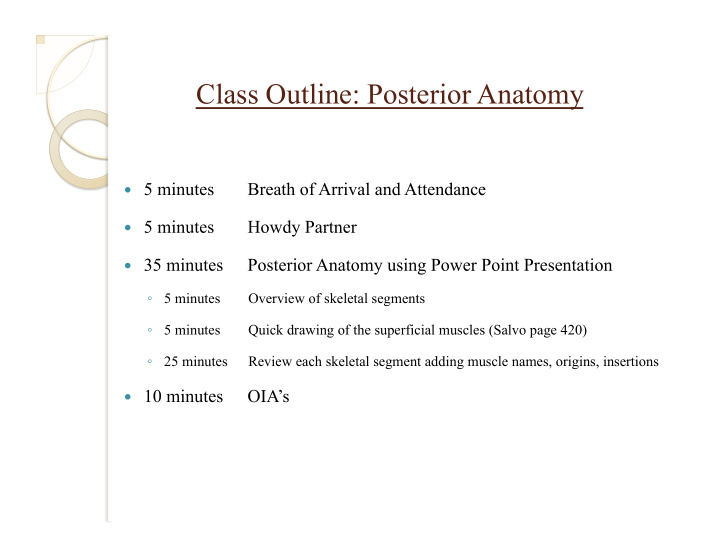



Class Outline: Posterior Anatomy 5 minutes Breath of Arrival and Attendance 5 minutes Howdy Partner 35 minutes Posterior Anatomy using Power Point Presentation ◦ 5 minutes Overview of skeletal segments ◦ 5 minutes Quick drawing of the superficial muscles (Salvo page 420) Review each skeletal segment adding muscle names, origins, insertions ◦ 25 minutes 10 minutes OIA’s
Classroom Rules Punctuality- everybody's time is precious: ◦ Be ready to learn by 9:00, we'll have you out of here by 1:30 ◦ Tardiness: arriving late, late return after breaks, leaving early The following are not allowed: ◦ Bare feet ◦ Side talking ◦ Lying down ◦ Inappropriate clothing ◦ Food or drink except water ◦ Phones in classrooms, clinic or bathrooms You will receive one verbal warning, then you'll have to leave the room.
Posterior Anatomy Names, locations, and shapes of muscles
Posterior Skeletal Segments Giving names to the bones on the back of the body.
Posterior Anatomy As we explore the skeletal segments, label them with the images supplied.
The Big Picture
Head Bones: skull or cranium
Neck Bones: cervical spine
Trunk Bones: thoracic spine, lumbar spine, and rib cage
Shoulder Girdle Bones: collar bone (clavicle) and shoulder blade (scapula)
Arm (upper extremity) Bones: arm bone (humerus), forearm bones (radius and ulna), and hand bones
Pelvic Girdle Bones: pelvic bones and tail bone (sacrum and coccyx)
Thigh Bones: thigh bone (femur)
Leg Bones: lower leg bones (tibia and fibula)
Foot Bones: heel bone (calcaneus), and lots of others
Posterior Muscles Giving names, shapes and locations to muscles
Let’s draw the superficial muscles!
Head These muscles will be covered in Class 11a: Muscles of the Head / Neck
Neck Muscle: upper trapezius Origin: skull and cervical spine Insertion: shoulder girdle (scapulae)
Neck Muscle: upper trapezius (upper traps) Origin: skull and cervical spine Insertion: shoulder girdle (scapulae)
Trunk Thorax and Lumbar Vertebrae
Trunk Muscle: middle trapezius (middle traps) Origin: thoracic spine Insertion: shoulder girdle (scapulae)
Trunk Muscle: lower trapezius (lower traps) Origin: thoracic spine Insertion: shoulder girdle (scapulae)
Trunk Muscle: rhomboids Origin: thoracic spine Insertion: shoulder girdle (scapulae)
Trunk Muscle: levator scapula Origin: cervical spine Insertion: shoulder girdle (scapulae)
Overview and Layers of the Trunk trapezius levator scapula rhomboids serratus anterior
Trunk Muscle: erector spinae (back strap muscles or spinal erectors) Origin: pelvis, spine, and ribs (lower) Insertion: upper spine and ribs, and skull
Trunk Muscle: latissimus dorsi (lats) Origin: pelvis, thoracic and lumbar spine Insertion: upper arm (proximal humerus)
Other stuff let’s zoom in . . .
Other stuff that we’ll study later teres major infraspinatus teres minor
Arm
Arm Muscle: deltoid (posterior deltoid) Origin: shoulder girdle Insertion: arm (humerus)
Arm Muscle: deltoid (posterior, middle, and anterior) Origin: shoulder girdle Insertion: arm (humerus)
Arm Muscle: triceps brachii (triceps) Origin: shoulder girdle Insertion: proximal forearm (ulna)
Arm Muscle: triceps brachii (triceps) Origin: shoulder girdle Insertion: proximal forearm (ulna)
Forearm Muscle: forearm extensors Origin: proximal arm (humerus) Insertion: fingers
Pelvis Gluteal muscles
Pelvis Muscle: gluteus maximus Origin: sacrum and upper (proximal) pelvis Insertion: upper thigh (proximal femur)
Pelvis Muscle: gluteus medius Origin: upper (proximal) pelvis Insertion: upper thigh (proximal femur)
Pelvis gluteus medius gluteus maximus
Thigh Hamstrings
Thigh Muscle: biceps femoris (lateral hamstring) Origin: Insertion:
Thigh Muscle: semitendinosus (medial hamstring) Origin: Insertion:
Thigh Muscle: semimembranosus (medial hamstring) Origin: Insertion:
Layering and Positioning of Thigh Muscles semimembranosus is deep to semitendinosus biceps femoris is lateral to semitendinosus and semimembranosus
Other stuff that we will study later adductors (from pelvis to femur) iliotibial band (from pelvis to tibia)
Leg Calf muscles, or calves
Leg Muscle: gastrocnemius (gastroc) Origin: lower thigh (distal femur) Insertion: heel bone (calcaneus)
Leg Muscle: soleus Origin: leg (tibia and fibula) Insertion: heel bone (calcaneus)
Layering of Leg Muscles gastrocnemius (superficial) soleus (deep)
Introducing the concepts of OIA Where do muscles begin and end? What do they do?
Where are the hamstrings?
The hamstrings are here . . . Let’s zoom in.
Please turn to packet page II-33
OIA’s (origin, insertion, and action) Belly The wide central portion of a skeletal muscle. Tendon Cord-like structure anchoring the end of a muscle to a bone. Origin Tendinous muscle attachment on the less movable bone. Insertion Tendinous muscle attachment on the more movable bone. Action The movement caused by the contraction of a muscle.
Biceps Femoris Origin: • Ischial tuberosity • Linea aspera of femur Insertion: • Head of fibula Actions: • Flex the knee • Extend the hip Resource Pages Salvo: 538 Trail Guide: 311-313 Coloring Book: 55
Semitendinosus Origin: • Ischial tuberosity Insertion: • Medial proximal tibia (AKA: pes anserinus) Actions: • Flex the knee • Extend the hip Resource Pages Salvo: 538 Trail Guide: 311-313 Coloring Book: 55
Semimembranosus Origin: • Ischial tuberosity Insertion: • Posterior medial tibial condyle Actions: • Flex the knee • Extend the hip Resource Pages Salvo: 537 Trail Guide: 311-313 Coloring Book: 55
Hamstrings: the posterior thigh muscles
Posterior Anatomy Names, locations, and shapes of muscles
Recommend
More recommend